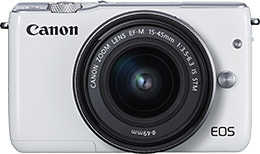Improve Your Travel Photos with the EOS M10 #1: Using Bokeh to Isolate Subjects
It’s natural to want to take lovely photos to preserve your fond memories of the scenes, experiences and food that you come across while on holiday. Lightweight, compact and easy-to-use, the EOS M10 is ideal for travel photography. In this article, we show you how to make use of bokeh (background defocus) to make your travel photographs look more impressive. (Photos by: Takeshi Akaogi, Edited by: Etica)

EOS M10/ EF-M22mm f/2.0 STM/ FL: 22mm (35mm equivalent)/ Aperture-priority AE (f/2, 1/500 sec)/ ISO 200/ WB: Auto
Increasing the background blur can emphasize the objects you want to shoot
Use a smaller aperture value to increase the defocused area in front and behind the subject
There is a technique to make your photos look more impressive to the viewer, and that is by creating a well-defocused bokeh effect. The word ‘bokeh’ refers to the aesthetically-pleasing defocused parts of the photo outside of the subject in focus, and is often also referred to as 'background blur' or 'foreground blur'. This defocused area can create a soft and soothing atmosphere in the photo. It also allows the photographer to lead the viewer’s line of sight to the area in focus and makes it easy to convey his intentions to whoever is looking at the photograph.
f/2

f/8

Left: EOS M10/ EF-M22mm f/2.0 STM/ FL: 22mm (35mm equivalent)/ Aperture-priority AE (f/2, 1/125 sec, EV+0.3)/ ISO 200/ WB: Auto
Right: EOS M10/ EF-M22mm f/2.0 STM/ FL: 22mm (35mm equivalent)/ Aperture-priority AE (f/8, 1/60 sec, EV+0.3)/ ISO 1600/ WB: Auto
Using f/2 defocused both the foreground and background of the image, creating a bokeh effect which makes the chestnut stand out more than at f/8 (right) where almost everything is depicted in focus.
To create a well-defocused bokeh effect, use a small aperture value and get close to your subject
In order to achieve a photo with a bokeh effect where the defocused area is so large that the entire area outside the point of focus is intentionally blurred, use the Aperture-priority AE (Av) shooting mode and adjust the f-number to a smaller value. In the case of the EF-M22mm f/2.0 STM lens, the widest available aperture size is f/2. The closer you get to your subject, the more substantial the defocus effect.
Read more about: The Relationship Between Lens Aperture and Bokeh

EOS M10/ EF-M22mm f/2.0 STM/ FL: 22mm (35mm equivalent)/ Aperture-priority AE (f/2, 1/500 sec, EV+1.0)/ ISO 200/ WB: Auto
Here, focus was placed on the front portion of the beautifully-coloured stained glass. One way to create depth and dimension in an image is to position the camera at an angle diagonal from an otherwise flat subject, as in this image.

EOS M10/ EF-M22mm f/2.0 STM/ FL: 22mm (35mm equivalent)/ Aperture-priority AE (f/2, 1/25 sec, EV±0)/ ISO 6400/ WB: Auto
This is an image of a dollhouse. I placed the point of focus on the books in front and created a bokeh effect in the far back of the image in order to create a soft, soothing atmosphere.
FAQ: So what is Aperture-priority AE (Av) mode?
In Aperture-priority AE (Av) mode, the photographer determines the aperture value (f-number), allowing him/her to control the amount and extent of bokeh in the photo. By setting the desired aperture value, the camera will automatically determine the optimal settings required for a proper exposure, namely shutter speed as well as ISO speed (if the ISO AUTO function is turned on).
Adjusting background defocusing in the easy-to-use ‘Creative assist’ mode will produce the same effect as setting a smaller aperture value. Being able to set the desired aperture value makes it possible to adjust the level of blurring of the background bokeh. In this way, you can gradually pick up the technical terms used in photography and master your camera’s functions, and take the photos you want. Be sure to give shooting in Aperture-priority AE (Av) mode a go!

To change the shooting mode to Aperture-priority AE (Av) mode, select the mode switch icon which is shaped like a camera (A). Next, after selecting the camera icon marked with a ★ (B), either turn the electronic dial or touch the screen to choose “Aperture-priority AE (Av) mode”.

For more tips and tutorials on using your EOS M10, head to:
In Focus: M3 & M10 Techniques and Reviews
Receive the latest update on photography news, tips and tricks.
Be part of the SNAPSHOT Community.
Sign Up Now!
About the Author
Etica Co., Ltd. not only run photography classes under the name “Tanoshii Camera School", but also edit publications and plan media and events related to cameras and photography, with a focus on themes related to child care, animals and food. Their motto is "Photos make people happy!" and they are engaged in communicating the charm of cameras and photography.
As a photographer, Akaogi works mainly for magazines and writes books introducing photography and practical tips. He also teaches at photography workshops.


































